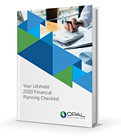Here’s How Much You Should be Saving for Retirement
By Jesse Giordano, CFP® | January 29, 2021When it comes to saving for the future, there isn’t a one-size-fits-all approach. Every individual is different, and we all have our own unique long-term goals and cash flow realities. As such, one person’s ideal retirement savings target may feel wholly unrealistic to another.

While your retirement plan should be tailored specifically to you, getting in the habit of setting aside 20% of your income for your future is a solid goal. It’s a benchmark that’s designed to put you in the best position to retire comfortably when the time comes. If you aren’t quite there yet, there’s no need to get down on yourself. It’s all about starting where you are—whether 5% or 10%—and building momentum from there.
The beginning of a new year is a particularly great time to establish new habits. In fact, research shows that we’re more likely to succeed when our resolutions are focused on adding new behaviors, as opposed to erasing old ones. To put it another way, adopting the mindset of “I will start to” appears to be much more empowering than “I will quit or avoid.” With the right thinking, it’s more than possible for 2021 to be the year that you start making real headway on your retirement savings.
Familiarizing Yourself with the 50/30/20 Rule
The 50/30/20 rule is a retirement planning formula that’s meant to help you live comfortably today while setting yourself up for success in the long term. Sticking with it means earmarking your income as follows:
- 50% for essentials: This includes your mortgage, rent, groceries, car payments, insurance, and other core expenses.
- 30% for discretionary spending: This is where you budget for fun and other non-essentials. Expenses in this category can cover everything from restaurant outings to concert tickets to shopping trips.
- 20% for savings: This category is reserved for retirement and other long-term goals.
The best way to begin is to first understand where you are. We’d suggest doing a quick review of your spending over the past several months. The Opal Monthly Budget Guide is perfect for this. Looking back on your debit and credit card statements can help clarify your spending habits. You may find that you’re spending much more, or less, in different categories. At that point, you can tweak the 50/30/20 approach so that it feels right to you. (More on this shortly.)
With that said, routinely saving 20% of your income for retirement can ultimately lead to a big payoff. Use our calculator below to provide numbers as an example showing how the earlier you start, the more you’ll have come retirement.
The 50/30/20 Budget
Calculate according to your income:
Your monthly income after taxes
How you should organize your money and budget:
Essentials (50%)
Discretionary spending (30%)
Savings (20%)
Fine-Tuning the 50/30/20 Rule to Fit Your Lifestyle
You might discover that some expenses, like saving for short-term goals, don’t fit neatly into one category. Instead of dipping into that 20% retirement bucket, see if you have wiggle room elsewhere. For example, is it possible to trim your essential spending by, say, 5%? The money you unlock here could be put toward short-term goals such as vacations or a child’s educational expenses.
Alternatively, you may have more freedom to pull from your discretionary spending, depending on your lifestyle. Either way, it’s an experiment that highlights the importance of keeping fixed and nonessential spending as low as possible—doing so can provide financial breathing room and free up resources for both your short- and long-term goals.
When all is said and done, saving 20% of your income for retirement may feel unworkable at the moment. You can begin with a lower target while setting your sights on 20% as the ultimate goal. If you get in the habit of saving just 5%, that’s a great start that’s better than saving nothing at all. You can even play a game with yourself where you see if you can increase that number by 1% each quarter. You can also use salary increases to push that number up even more. Picking up a side hustle is another way to get you closer to your goal without impacting your regular cash flow. Whatever it is, start somewhere while you march toward that 20% target.
The 50/30/20 rule can help in establishing retirement savings benchmarks that get you moving in the right direction. However, fitting your unique financial situation into these guidelines may feel like a challenge. This is precisely why it’s so important to connect with an experienced financial advisor who understands your long-term goals and vision for retirement. Together, we can create a customized strategy that’s designed specifically for you. Talk with Opal Wealth Advisors today to get started.
Be a Smart Investor
Stay up-to-date with industry-leading information and news delivered straight to your inbox.
Get our timely insights delivered to your inbox (Blog)
Please remember that past performance may not be indicative of future results. Different types of investments involve varying degrees of risk, and there can be no assurance that the future performance of any specific investment, investment strategy, or product (including the investments and/or investment strategies recommended or undertaken by Opal Wealth Advisors, LLC [“OWA]), or any non-investment related content, made reference to directly or indirectly in this commentary will be profitable, equal any corresponding indicated historical performance level(s), be suitable for your portfolio or individual situation, or prove successful. Due to various factors, including changing market conditions and/or applicable laws, the content may no longer be reflective of current opinions or positions. Moreover, you should not assume that any discussion or information contained in this commentary serves as the receipt of, or as a substitute for, personalized investment advice from OWA. OWA is neither a law firm, nor a certified public accounting firm, and no portion of the commentary content should be construed as legal or accounting advice. A copy of the OWA’s current written disclosure Brochure discussing our advisory services and fees continues to remain available upon request or at www.opalwealthadvisors.com. Please Remember: If you are a OWA client, please contact OWA, in writing, if there are any changes in your personal/financial situation or investment objectives for the purpose of reviewing/evaluating/revising our previous recommendations and/or services, or if you would like to impose, add, or to modify any reasonable restrictions to our investment advisory services. Unless, and until, you notify us, in writing, to the contrary, we shall continue to provide services as we do currently. Please Also Remember to advise us if you have not been receiving account statements (at least quarterly) from the account custodian.



